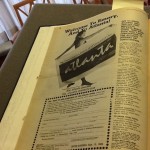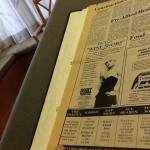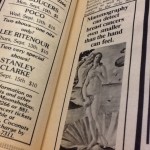It’s very interesting to compare the Emory campus of 1984 to that of 2012. The culture is differing yet has some of the same images when it comes to sexual orientation acceptance on Emory’s campus.
One of the most interesting things I found in the 1984 Emory Wheel was the name of the LGBT organization at the time. Student Action for Human Rights was a club in 1984 at Emory that advocated for “lesbian and gay concerns.” The terms bisexual and transgender did not even make the ad for promotion of this organization. This can be tied to the “Sexual Desire and Gender” article by Pepper Schwartz and Virginia E. Rutter. In this article the social construction of sexuality was discussed. As said in the article, the United States is very complex when it comes to this subject. Social construction can get very detailed to hone in on a person’s family as their main influence in their outlook on and position in society. Even though overall America has accepted pre-marital sex, many families do not condone this behavior and this in turn affects the children’s actions. They will either accept their parents wishes or find their own way while rebuking their families’ ideals.
To bring this back to Emory’s 1984 Student Action for Human Rights, organizations can be socially constructed just as much as a human being. Although Emory was more tolerant of different sexual orientations than other schools, they could not have the organization have any hint of sexual orientation advocacy in the name. Having an umbrella term such as “human rights” in the name helped Emory still keep a mildly conservative image in order to still engage those that are not as forthcoming in their sexual identity.
Another interesting aspect of the Emory Wheel from 1984 was the use of women in advertisements. In the advertisements that cascaded across the newspaper, there were numerous women in little to no clothing that had nothing to do with the product being sold. One of the ads for a package store had a woman wearing a tight dress holding a wine glass. The only pertinent aspect of this image is the wine glass yet the woman is being objectified to advertise the package store. Another example is an ad or the Atlanta Journal Constitution. A woman is holding an Atlanta banner behind her back. Again,this has nothing to do with the advertising of the Atlanta Journal Constitution. The last example is the use of “The Birth of Venus” by Botticelli to advertise to use mammograms in order to prevent late detection of breast cancer. It is interesting that the first two examples had real women used to pull viewers into the ads, but for a mammogram a piece of famous art was used. This could be due to the separation of men and women in socially constructed society. As the reading from Schwartz and Rutter says, women were thought of as housewives while men were thought to go out and make the money for the family. To have the goddess of love and desire as an ad is a very interesting combination of societal influence and propaganda. Women of this time inadvertently had a solidarity with Venus because of how they were though of at the time. If there were a famous painting of Hestia, the goddess of hearth and home, I believe it would be the first and only choice for an ad to bring in women and make men subconsciously enticed to view the ad as well.




Simoneh: Could you post a picture or two of what you found in the archives? I am not surprised there was no “B” or “T” those became accepted much later in LGBT discourse. And I find your interpretation of the title “Student Action for Human Rights” interesting. I think this title could absolutely be a response to the homophobia of the time and an effort to avoid any type of gay bashing of the group. I wonder though if it could also have been an effort to build coalitions across groups of people who are working against any type of systemic oppression: like anti-racist groups, feminist groups, anti-war groups, etc. What do you think?
Although the name of the organization was Student Action for Human Rights, their ads always said under the name to come to meetings to talk about gay and lesbian issues. That is why I still believe it is a response to the homophobia of the time and avoid gay bashing.